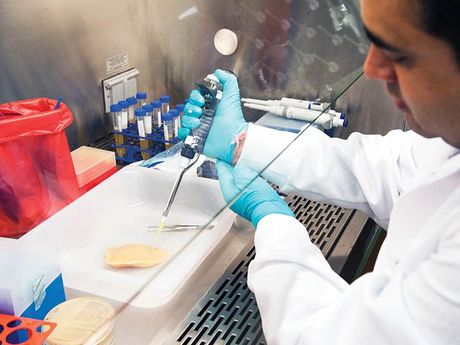Stopping foodborne bacteria at the source

An antimicrobial effective against Campylobacter jejuni may offer poultry and meat processors a way to safely extend shelf life and minimise the risk of foodborne disease.
Salmonella and Campylobacter cause foodborne disease in millions of people every year, possibly because both bacteria are present in healthy poultry and beef.
While good food handling practices and thorough cooking by consumers usually prevent the bacteria from causing illness, a more effective control would be to rid poultry of these common bacteria before they ever leave the processing plant. Scientists at Mississippi State University are working to do just this.
They recently tested the use of lauric arginate, an antimicrobial compound approved by the USDA, as a processing aid to assist in the fight against Campylobacter jejuni (C. jejuni) and Salmonella. The scientists are also researching if the compound extends the shelf life of poultry, which is currently limited to about a week.
“Lauric arginate has been tested against various foodborne pathogens including Listeria monocytogenes, Salmonella and E. coli,” said Chander Sharma, Mississippi Agricultural and Forestry Experiment Station researcher and assistant professor in the Department of Poultry Science. “However, there is limited data on the use of lauric arginate against Campylobacter in the meat system.”
Foodborne illness from C. jejuni affects nearly one million people each year. To determine the effectiveness of lauric arginate against C. jejuni and Salmonella, scientists conducted a series of experiments.
The first experiment tested the effectiveness of the preservative on a pure culture of C. jejuni. Samples of the bacteria were placed in a test tube along with varying solutions of the preservative. Lauric arginate was very effective at destroying the bacteria with no detectable survivors.
Scientists then coated the outside of raw chicken breast fillets with C. jejuni, treated it with lauric arginate, then packaged and refrigerated the meat for a week.
Samples were taken periodically to determine if lauric arginate was effective in removing the bacteria.
“At day seven, we had a 94 to 95% reduction of Campylobacter jejuni in the inoculated chicken breast,” Sharma said. “The preservative reduced Salmonella by 80 to 90%.”
Findings show that lauric arginate is very effective at controlling C. jejuni in raw poultry products. It is also good at controlling Salmonella, Sharma added.
“Poultry processors chill birds immediately after slaughter to prevent bacterial growth either through air chilling or water chilling,” Sharma said. “Lauric arginate may be applied during post chill to control foodborne bacteria.”
In a separate experiment, scientists treated raw chicken breast fillets with lauric arginate to determine if the preservative extends the shelf life of poultry.
“The shelf life of poultry is typically seven days, and when you consider the transportation of poultry — from processing to retail grocery store to your home — poultry has a very short shelf life,” Sharma said. “If we can safely extend this time, everyone benefits.”
To determine if the shelf life is extended, scientists measure mesophilic bacteria — those responsible for decomposition — and psychrotrophic bacteria — those responsible for spoilage of refrigerated food.
The preservative had little effect on these bacteria, suggesting that further work may need to be done with higher rates of application considered.
With consumer demand for poultry and non-preservative-based foods increasing, scientists are also studying the use of bacteriophage in poultry processing. Bacteriophage is a virus that attacks bacteria. It is very specific in targeting its host.
“In our trials, we found bacteriophage reduces Salmonella by 90% in chicken and turkey meat when applied during the post chill processing,” Sharma said. “More research is needed but bacteriophage may be the answer to a non-preservative-based additive to assist in the fight against foodborne illnesses.”
When applied sequentially with other USDA-approved antimicrobials, bacteriophage reduced Salmonella by 99%, Sharma added.
For the sake of saké: combating beverage fraud in Japan
In order to help combat the global issue of saké fraud, researchers have developed an...
Hygienic design: keeps the bugs away
When sanitisation practices are insufficient, listeria can harbour and thrive in many pieces of...
Meat processing: a case study of Triton and GMP collaboration
Gundagai Meat Processors (GMP) and Triton Commercial Systems have collaborated on an innovative...












